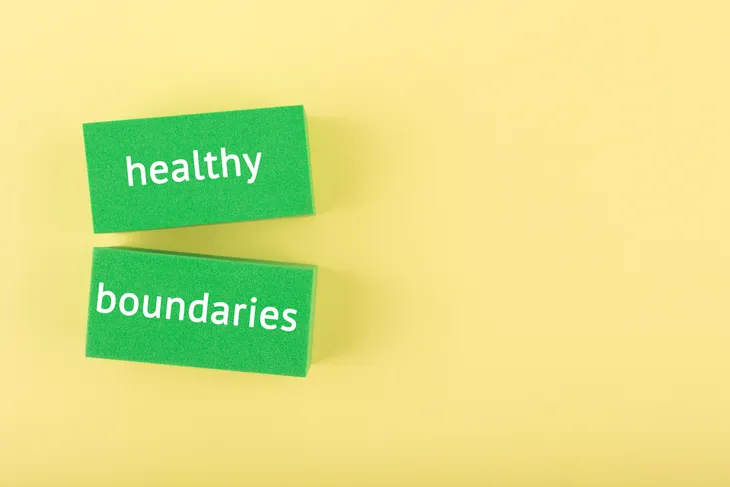- Trauma dumping is the oversharing of difficult emotions and thoughts with others in a way that is harmful to the other person.
- It differs from venting because the other person can’t respond, they don’t take accountability for their actions, and often jump from topic to topic talking longer than necessary.
- When dealing with a trauma dumper try to set clear boundaries, shift or limit the conversation, and be honest and direct about it.
We’ve all been there before after a bad day. You’re upset and need to vent, so we unload it all on our co-worker, best friend, or relay it to our partner at the end of the day. While this type of behavior is totally normal and can be helpful to allow people to voice their frustration and move on, how much is too much or too often?
According to researchers, too much venting or negative sharing can become toxic. This is when it becomes trauma dumping — “the act of oversharing your emotions in a way that becomes harmful to the other person,” explains the Cleveland Clinic. Here’s an in-depth look into what trauma dumping is and how to deal with it…
What is Trauma Dumping?
Trauma dumping is different than a normal conversation between close friends. It’s a long, uninterrupted venting session about something very stressful, painful, or a traumatic experience. VeryWell Mind explains that it can happen between friends, family, or even coworkers and acquaintances. It usually happens without the other person’s consent.
“Trauma dumping refers to the oversharing of difficult emotions and thoughts with others,” says psychologist Kia-Rai Prewitt, PhD to the Cleveland Clinic. “It is not a clinical term used by mental health providers, but people who engage in ‘trauma dumping’ often share traumatic events or stressful situations with others during inappropriate times.”
People who engage in this behavior are often going through some type of distress, such as depression, anxiety, or dealing with a stressful home or work environment, notes the source.
Examples of Trauma Dumping
According to the Cleveland Clinic, the biggest indicator of trauma dumping is when the other person in the conversation isn’t given a chance to respond or share their emotions. “The person on the receiving end of these thoughts and emotions often feels overwhelmed and helpless because they aren’t sure how to respond or may not be given an opportunity to respond,” explains Dr. Prewitt to the source.
The Cleveland Clinic provides two good examples of trauma dumping that might occur. The first is a coworker who shares specific details of a difficult divorce while in a casual setting like a lunch with colleagues. This would be inappropriate and too personal for a coworker relationship. The other is a friend who shares details of their toxic relationships without even asking or allowing the other person to share details about their day. This person basically treats their friends like a therapist.
Venting vs. Trauma Dumping
It can be hard to tell the difference between trauma dumping which is seen as toxic behavior and normal venting which can be healthy for people. However, the Cleveland Clinic notes there are some key differences. Healthy venting is sharing frustrations with someone, whereas trauma dumping is oversharing at inappropriate times. It’s okay to have a mutual venting session with someone, but not allowing the other person to share is considered trauma dumping.
People who are simply venting will often take accountability for their mistakes in relation to the problem and are open to finding solutions, whereas trauma dumping they won’t take accountability and aren’t open to problem-solving. And finally, venting often has a time frame and is dedicated to one topic of frustration at a time. People who are trauma dumping will jump from topic to topic quickly and talk too long about too many issues, explains the source.
Why is it Toxic?
It’s one thing if two people are leaning on each other for mutual emotional support, but Choosing Therapy points out that trauma dumping often isn’t a mutual interaction. It’s considered toxic because one person is having their needs met at the expense of someone else. This is a recipe for a one-sided and strained relationship.
The pressured speech and emotional content that often occurs in trauma dumping can invoke the fight or flight response in whoever is listening. “This refers to how the brain responds to threats, causing a chain reaction in the brain, nervous system, and body. When this happens too often, the stress hormones emitted can cause chronic or toxic stress,” writes the source. It’s important to note that trauma dumping often isn’t harmful or done maliciously. It’s simply an unhealthy, ineffective way of seeking emotional support, says Choosing Therapy. The people doing it usually have anxiety, depression, or low self-esteem.
Social Media and Trauma Dumping
Trauma dumping can also occur online. According to Choosing Therapy, when it’s done on social media it’s sometimes called stress posting, sad phishing, T.M.I., or just oversharing. It’s when people post overly personal information online, particularly things that reference taking their own life, mental illness, self-harm, or traumatic personal experiences.
People tend to do a lot of trauma dumping on social media because for some, it’s easier for them to share their feelings online than to talk in person. “It’s much safer to share your pain on a platform, behind a screen. With more and more people on social media, it has become a safer place to share personal stories and information more readily,” says Gina Moffa, LCSW, psychotherapist to VeryWell Mind.
There’s a tendency to use social media as a platform for trauma dumping because it reaches so many people, making it more likely to get the validating response that a person is looking for rather than differing opinions that force them to reevaluate their actions, explains the source. However, Choosing Therapy warns that this can backfire and open people up to criticism which can leave them feeling embarrassed, exposed, or emotionally unstable.
Trauma Dumping and PTSD
Not every person behind trauma dumping is dealing with post-traumatic stress disorder (PTSD). People sometimes assume that someone dumping trauma is suffering from PTSD, but that’s not the case. In fact, Choosing Therapy points out that most people with PTSD don’t talk about their traumatic memories or experiences with other people. They are more likely to avoid them, particularly any reminders, memories, or feelings attached to them.
Oversharing isn’t a common trauma response and trauma dumping isn’t necessarily linked to PTSD. Avoidance and under-sharing are common symptoms of PTSD, explains the source. “Trauma dumping isn’t one of the symptoms of PTSD or any other mental health condition, but many who have this issue do struggle with emotional regulation, loneliness, and possibly depression, anxiety, and low self-esteem,” writes Choosing Therapy.
How it Affects Relationships
Friends and family often want to support us as a shoulder to lean on or an ear to listen. But don’t take advantage of them. This is especially true in relationships that might not be that close, such as an acquaintance or coworker. Trauma dumping can not only be uncomfortable for them, but also push them away.
“The harm in trauma dumping is that it often crosses the listener’s boundaries. It can also negatively impact their mental health by increasing their anxiety and stress levels,” explains Dr. Prewitt to the Cleveland Clinic. As a result, it can jeopardize the relationship. The source even warns that trauma dumping could be seen by others as being manipulative. This is especially true if the listener feels the relationship is one-sided.
Signs You’re a Trauma Dumper
Some people reading this might be able to relate being the dumpee, while others worry they are a trauma dumper. Don’t fret! It’s not something that can’t be unlearned or that a little more self awareness can’t fix. The Cleveland Clinic reassures the best thing someone who may be trauma dumping can do is pay attention to how they are communicating.
The source provides a list of things to consider or ask themselves when sharing a difficult trauma with others…
- Did they get a chance to share their own feelings?
- Does this person feel comfortable sharing their traumas with me?
- Am I sharing these difficult feelings at an appropriate time?
- Did I ask the person if they felt overwhelmed by what I was talking about?
- Are there certain topics I should share with a therapist instead?
How to Deal with Trauma Dumping
Shift and Limit the Conversation
At the first sign of trauma dumping, try to shift the conversation into a more positive direction. Don’t let them control the entire conversation. Choosing Therapy suggests interjecting with a light-hearted comment or respond, “that sucks, I’m really sorry.” Then change the topic. This approach doesn’t always work, but it’s a good place to start especially before the dumping begins.
You should also try to set a limit on the conversation. You can do this by telling them upfront, “I’m on my way home so I have about 15-minutes before I have to go.” This way they aren’t entirely shocked or offended when the conversation is cut short.
Don’t Pick Up Their Problem
The term comes from the fact that this person is literally dumps all their problems and stresses onto someone else. To be on the receiving end of that is difficult! People who engage in this type of behavior need to learn how to deal with their own issues and feelings, says Choosing Therapy.
While it might seem natural to offer them solutions and engage back with them, don’t. The source says this only enables their trauma dumping behavior and doesn’t help them. Plus, they likely aren’t open to solutions. Don’t pick up on their issues. Instead ask them what they, themselves plan to do to fix the problem.
Be Honest and Direct About It
People who engage in trauma dumping are often in some type of emotional distress, so it can be difficult to disengage without hurting their feelings. But when subtle tactics fail, Choosing Therapy suggests just being honest and direct about it. Explain to them how and why their behavior is affecting you.
It might be uncomfortable, but it helps to remind them their is another person in the conversation with feelings too. You can never be faulted for being honest. The source advises telling them you have too much on your plate and aren’t in the right headspace to offer support.
Set Boundaries
If you’re feeling uncomfortable, it’s important to set boundaries. It doesn’t have to be in a dismissive way. When talking with VeryWell Mind, Brittany Becker, LMHC, director at The Dorm advises validating the person’s feelings and showing them empathy, but then voice any discomfort about being in the conversation.
“[Then offer] to help them secure the more helpful person or professional to talk to about this,” adds Becker to the source. “They need someone to gently guide them through their narrative and help them find a place where they can safely self-reflect, therefore, garnering more of a sense of empowerment over their life, and story.”















